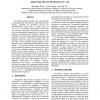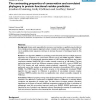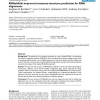820 search results - page 6 / 164 » Using Multiple Alignments to Improve Gene Prediction |
CSB
2005
IEEE
14 years 28 days ago
2005
IEEE
In bacterium, genes working in the same pathway or interacting with each other are often organized into operons. Currently, the prediction accuracy for operon/boundary gene pairs ...
BMCBI
2008
13 years 7 months ago
2008
Background: Amino acids responsible for structure, core function or specificity may be inferred from multiple protein sequence alignments where a limited set of residue types are ...
BIBM
2008
IEEE
14 years 1 months ago
2008
IEEE
The study of gene function is critical in various genomic and proteomic fields. Due to the availability of tremendous amounts of different types of protein data, integrating thes...
BMCBI
2008
13 years 7 months ago
2008
Background: The prediction of a consensus structure for a set of related RNAs is an important first step for subsequent analyses. RNAalifold, which computes the minimum energy str...
BMCBI
2006
13 years 7 months ago
2006
Background: Several entropy-based methods have been developed for scoring sequence conservation in protein multiple sequence alignments. High scoring amino acid positions may corr...



